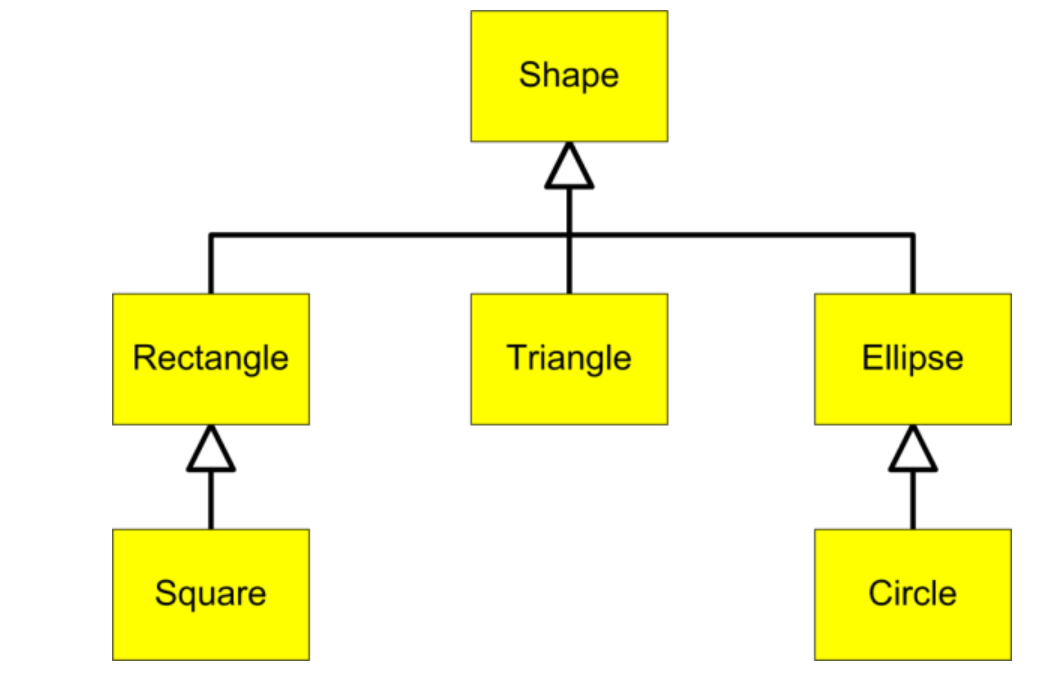📓9.5: Hierarchies
Table of Contents
📖 This page is a condensed version of CSAwesome Topic 9.5
Inheritance Hierarchies
If you have multiple subclasses that inherit from a superclass, you can form an inheritance hierarchy. Every subclass is-a or is a kind of the superclass, and the hierarchy can reach many levels.
For example, here is an inheritance hierarchy of shapes:

Squareis-aRectangleand a subclass of Rectangle.Rectangleis-aShapeand a subclass of Shape. In Java, the classObjectis always at the top of any hierarchy. Every class in Java inherits from Object and is-an Object.
One of the main reasons to use an inheritance hierarchy is that all the classes in the hierarchy can be treated as instances of the top type in the hierarchy. This is called polymorphism and we’ll discuss it in more detail in the next section.
Inheritance can also reduce code duplication since common behaviors can be defined in methods in a superclass and inherited by all their subclasses.
But you should never use inheritance just to reuse code if there isn’t a true “is-a” relationship between the subclass and the superclass!
💬 DISCUSS:
- What variables and methods might be inherited from the superclass
Shapein the inheritance hierarchy above? - Can you make a 3-level inheritance hierarchy for living things on Earth?
Superclass References
A superclass reference variable can hold an object of that superclass or of any of its subclasses.
For example, a Shape reference variable can hold a Rectangle or Square object:
// The variables declared of type Shape can hold objects of its subclasses
Shape s1 = new Shape();
Shape s2 = new Rectangle();
Shape s3 = new Square();
Notice that the opposite is not true! You cannot declare a variable of the subclass but then construct a superclass object.
For example, a Square reference cannot hold a Shape object because not all Shapes are Squares:
// A subclass variable cannot hold the superclass object!
// A Square is-a Shape, but not all Shapes are Squares.
Square q = new Shape(); // ERROR!!
The code above will give an “Incompatible types: Shape cannot be converted to Square” error.
Why is using a superclass reference for subclass objects useful? Because now, we can write methods with parameters of type Shape, or have arrays of type Shape, and use them with any of its subclasses as seen in the next sections.
Superclass Method Parameters
Another advantage of an inheritance hierarchy is that we can write methods with parameters of the superclass type, but then pass in subclass objects to them.
For example, the print(Shape) method below could be called with many different Shape subclasses and work for Rectangles, Squares, etc.
// This will work with all Shape subclasses (Squares, Rectangles, etc.) too
public void print(Shape s) {
...
}
Notice that in the following code, the print method has a parameter of type Person, but it can be called with Student or Person objects in the main method. How do we know which toString method is called? It depends on whether a Person or Student is passed in at runtime.
public class Tester {
public static void main(String[] args) {
Person p = new Person("Sila");
Student s = new Student("Tully", 1001);
System.out.println(p); // call print with a Person
System.out.println(s); // call print with a Student
}
}
public class Person {
private String name;
public Person(String name) {
this.name = name;
}
public String toString() {
return name;
}
}
public class Student extends Person {
private int id;
public Student(String name, int id) {
super(name);
this.id = id;
}
public String toString() {
return super.toString() + " " + id;
}
}
💬 DISCUSS: Which
toString()method is called? What would happen if you commented out thetoStringmethod inStudent? Which one would be called now?
Superclass Arrays and ArrayLists
Using inheritance hierarchies, we can create arrays and ArrayLists using the superclass type and put in values that are of the subclass types. This can be very useful!
For example, here is some code that creates a Shape[] array and an ArrayList<Shape>, both of which can hold any objects of Shape AND any of its subclasses:
// This shape array can hold the subclass objects too
Shape[] shapeArray = { new Rectangle(), new Square(), new Shape() };
// The shape ArrayList can add subclass objects too
ArrayList<Shape> shapeList = new ArrayList<Shape>();
shapeList.add(new Shape());
shapeList.add(new Rectangle());
shapeList.add(new Square());
💻 In-Class Activity: Shopping Cart
⭐️ Summary
-
An inheritance hierarchy of subclasses inheriting from superclasses can be formed with
Objectbeing the top of the hierarchy. -
When a class S “is-a” class T, T is referred to as a superclass, and S is referred to as a subclass.
-
If S is a subclass of T, then a reference of type T can be used to refer to an object of type T or S. This is called polymorphism, defined more in the next lesson.
-
Declaring references of superclass type T, when S is a subclass of T, is useful in the declaring of:
- Formal method parameters of type T
- Arrays of type T
- ArrayList of type T
Acknowledgement
Content on this page is adapted from Runestone Academy - Barb Ericson, Beryl Hoffman, Peter Seibel.